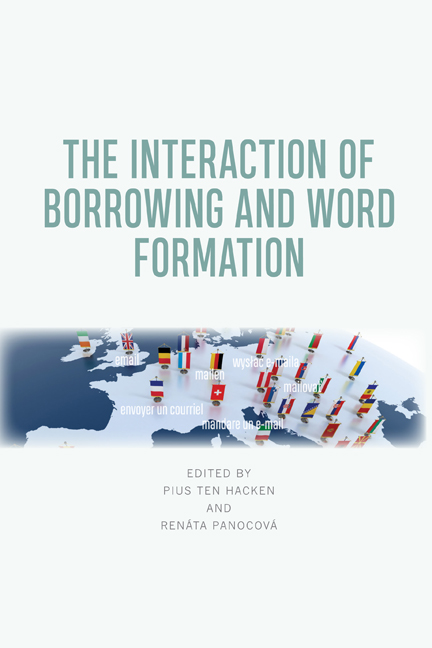Book contents
- Frontmatter
- Contents
- List of Figures and Tables
- List of Contributors
- Preface
- List of ISO-639 Language Codes
- Introduction
- 1 Word Formation, Borrowing and their Interaction
- Part I Compounding
- 2 Compounding and Contact
- 3 Neoclassical Compounds between Borrowing and Word Formation
- 4 Borrowed Compounds, Borrowed Compounding – Portuguese Data
- 5 Compound Calques in an Eighteenth-Century German-Lithuanian Dictionary
- 6 (Pseudo-)Anglicisms as Nominal Compounds in Italian
- Part II Affixation
- 7 The Role of Borrowing in the Derivation of Passive Potential Adjectives in Polish
- 8 How an ‘Italian’ Suffix Became Productive in Germanic Languages
- 9 The Suffixes -ismus and -ita in Nouns in Czech
- 10 The Interaction between Borrowing and Word Formation: Evidence from Modern Greek Prefixes
- Part III Naming in Minority Languages
- 11 Loanword Formation in Minority Languages: Lexical Strata in Titsch and Töitschu
- 12 Examining the Integration of Borrowed Nouns in Immigrant Speech: The Case of Canadian Greek
- 13 Interaction among Borrowing, Inflection and Word Formation in Polish Medieval Latin
- Conclusion
- 14 Trends in the Interaction between Borrowing and Word Formation
- Author Index
- Subject Index
4 - Borrowed Compounds, Borrowed Compounding – Portuguese Data
Published online by Cambridge University Press: 22 September 2020
- Frontmatter
- Contents
- List of Figures and Tables
- List of Contributors
- Preface
- List of ISO-639 Language Codes
- Introduction
- 1 Word Formation, Borrowing and their Interaction
- Part I Compounding
- 2 Compounding and Contact
- 3 Neoclassical Compounds between Borrowing and Word Formation
- 4 Borrowed Compounds, Borrowed Compounding – Portuguese Data
- 5 Compound Calques in an Eighteenth-Century German-Lithuanian Dictionary
- 6 (Pseudo-)Anglicisms as Nominal Compounds in Italian
- Part II Affixation
- 7 The Role of Borrowing in the Derivation of Passive Potential Adjectives in Polish
- 8 How an ‘Italian’ Suffix Became Productive in Germanic Languages
- 9 The Suffixes -ismus and -ita in Nouns in Czech
- 10 The Interaction between Borrowing and Word Formation: Evidence from Modern Greek Prefixes
- Part III Naming in Minority Languages
- 11 Loanword Formation in Minority Languages: Lexical Strata in Titsch and Töitschu
- 12 Examining the Integration of Borrowed Nouns in Immigrant Speech: The Case of Canadian Greek
- 13 Interaction among Borrowing, Inflection and Word Formation in Polish Medieval Latin
- Conclusion
- 14 Trends in the Interaction between Borrowing and Word Formation
- Author Index
- Subject Index
Summary
Morphological compounding is a quite recent word formation resource in Portuguese and its appearance is quite surprising since no other word formation innovation took place for more than seven centuries. This novelty was most probably triggered by an indirect situation of language contact, which yielded a particular kind of borrowing, both lexical (neoclassical roots) and structural (neoclassical compounding).
In section 1, I will briefly present a historical characterisation of the Portuguese lexicon and Portuguese borrowings, in order to locate the appearance of neoclassical compounds and neoclassical compounding in the language diachrony. In section 2, I will relate this borrowing in Portuguese to similar cases in other European languages, stressing that the same process was available, at the same time, for a large number of European languages, which facilitated a cross-linguistic spreading of these words. In section 3, I will present a description of Portuguese neoclassical compounds and the new morphological compounding process and I will conclude in section 4 that these particular loans require a reappraisal of the concept of lexical borrowing.
Brief survey of the history of the Portuguese lexicon and Portuguese borrowings
The Portuguese lexicon has a Latin matrix, complemented by a fuzzy set of traces from substrata languages (namely Basque, e.g. esquerdo ‘left’, and Phoenician, e.g. ama ‘child-minder’) and a poorly documented contingent of vocabulary from Germanic (e.g. lofa ‘palm’ > luva ‘glove’) and Arabic (e.g. as-sukkar > açúcar ‘sugar’) superstrata. Its evolution in relation to political milestones and linguistic developments is summarised in Figure 4.1.
Though we can locate the founding dates of the Portuguese kingdom between the ninth and the twelfth centuries – and though it is also possible to document that the language spoken, by that time, in the Northwestern Iberian Peninsula was no longer Latin – Portuguese as a language was not acknowledged before the thirteenth century. So, in this early period, we can find two separate language shift processes: first, from native languages into Iberian Latin, and, second, from Iberian Latin into Galician-Portuguese. According to Thomason and Kaufman (1988: 37–38), we should find evidence of interference from substrata language ‘as the result of imperfect learning of a target language by a group of speakers of a native language’, but that is not exactly the case.
- Type
- Chapter
- Information
- The Interaction of Borrowing and Word Formation , pp. 49 - 66Publisher: Edinburgh University PressPrint publication year: 2020



